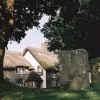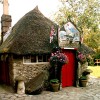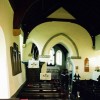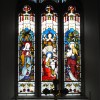One amazing fact about sheep is that there are more breeds of this domesticated animal in Britain than anywhere else in the world. But one breed above almost any other, through the human intervention of cross-breeding, has acquired the distinction of being especially adaptable to variable climates: the Dorset Horn.
The history of this handsome and hardy breed reaches back many centuries. South West Horn sheep already widespread on the downland of Wessex during the Roman occupation and by 1086 and beyond these sheep continued to have an important role in the local agrarian economy. The Dorset Horn, together with the Wiltshire Horn sheep, is believed to be progeny of the South-West Horn type. It is thought that the Dorset Horn had its origin many years before, some experts believing that the modern Dorsets carry genes of prehistoric flocks.
Then during the reign of Elizabeth I certain ships bearing cargoes of live sheep were shipwrecked off Portland during storms. Live sheep were then taken ashore, where they were cross-bred with native Dorset horns producing an offspring with a strain of Merino. The cross-breeding explains one of the Dorset’s most endearing and commercially valuable traits: its thick, short-wool coat, but also the characteristic pinkish face and the ewe’s ability to come into season throughout the year, enabling a farmer to benefit from the most profitable time of the year.
Ewes impregnated by rams in April would be walked to the sheep fairs in September where buyers from as far away as Edinburgh would buy the in-lamb ewes to satisfy the demands of the Christmas dinner table. In the early 1800’s a farmer at Plush called Michael Miller held the last pure Dorset Horn flock. The Dorset Horn was created by crossing the Somerset Horn with the Dorset Horned sheep, and Richard Seymour, a breeder at Bradpole in the 1830’s is widely acknowledged as the earliest improver of the breed. The number of Dorset Horns in the county appears to have reached its limit in the mid 19th century, but declined thereafter, so that by 1900 the number was down by fifty per cent. Another noted breeder/improver of Dorset Horns was Alfred Johnson, a former resident of Symondsbury House, who was also the first to export some of the rams to Australia and the first to make a hundred guineas from the sale of a ram.
In 1956 Mr J. Martin Lenthall of manor Farm, Burton Bradstock, worked a passage to Australia with a consignment of sheep, but also with the intention of carrying out a bit of sleuthing. For two years he went around investigating cattle and sheep stations to see whether hornless sheep were being developed. On arriving in Tasmania he was intrigued to discover a flock very similar to Dorset Horns but without horns. Lenthall returned with a stud ram and a ram lamb – the ancestors of the first Poll (hornless) Dorset Sheep. In 1966 Lenthall left the farm that had been in is family for several generations to begin a new life on a farm called Bradstock Downs near Albany in Western Australia. One of his married daughters (Mrs Beverley Hole) carried on the Lenthall tradition in Dorset.
Like the Dorset Horn, the Poll is unique in being able to breed at any time of the year and produces one of the highest quality wools completely free from grey fibres. The fleece is also very white, even before scouring. Since the 1900’s the breed has spread throughout Britain and more recently into Europe, since like its Dorset Horn ancestor it is able to cope with the varied climates of the continental region.
Physically the Dorset Horn breed has many stirling qualities. Overall, individuals are long in the body and have a very square chunky appearance. The horns are borne by ewes as well as rams and are especially massive, growing upward and then coiling forward close to the muzzle. The head is broad, full and open, the nostrils well covered and the nose pink. The neck is of short to medium length, strong, muscular and well-sprung from the shoulders; the chest is well forward, full and deep. A Dorset Horn’s hind quarters are full, with deeply muscled thighs and the legs are of medium length. There is a find, downy type of fleece free of kemp (course hair in wool) and colour, having firm handling.
Dorset Horn rams have a bold, muscular appearance, with a good length and a strong robust character. The head is one of great beauty with long, strong horns curving downwards and then forwards in graceful curves. Ewes are bright sheep with a feminine appearance and smaller, more delicate horns.
Temperamentally the breed is a docile one. In Britain Dorset Horns and Dorset Polls are naturally found mainly in the south-west region, though cross-breeds are more widely distributed. Because of their ability to cope with various climatic conditions and their other outstanding qualities the Dorset Horn (and particularly the Dorset Polls) are now widely distributed throughout the world, being especially popular in Australia, New Zealand and the USA. Poll meat is tasty and succulent with a high meat-to-fat and bone ratio suiting the needs of the post-millennium market.



